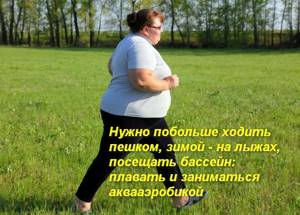Disruption of metabolic processes in the form of excessive obesity in the absence of proper treatment is fraught with serious consequences. To normalize weight indicators, diet therapy and physical activity are usually practiced, and, if necessary, medications are selected. Exercise therapy for obesity helps improve metabolism with subsequent elimination of extra pounds. Exercises should be started after consultation with a doctor, and it is important to properly prepare for the upcoming workouts.
The importance of physical therapy
In the formation of excess body weight, factors such as age, gender, decreased physical activity, and occupational hazards are of great importance. Therefore, treatment of obesity should be carried out in three directions:
- Identification and elimination of the cause of the disease;
- Reducing the daily calorie intake of food;
- Increased physical activity.
In the latter case, we are talking about physical therapy, which involves adequate physical activity. It will increase energy consumption, stimulate the breakdown of fat deposits, make muscles more prominent and make your figure slimmer.
Even if the main problem is a metabolic disease or dysfunction of the endocrine glands, exercise therapy will be an important addition to the prescribed drug therapy. It is impossible to lose weight to the desired weight on medications alone. And the more difficult it will be to maintain this weight in the future.
The problem of obesity also lies in the complications it gives to the heart, blood vessels, and musculoskeletal system. A well-chosen set of physical exercises, which can be performed daily, will normalize the functioning of all affected organs and reduce the load on the joints. Activation of the gastrointestinal tract will allow you to better process food and prevent fats from being deposited in the subcutaneous tissue.
Physical activity and exercise therapy in obese and overweight children
For children and adolescents with overweight and obesity leading a passive lifestyle, as well as for children and adolescents with severe obesity, a gradual increase in physical activity is recommended to ultimately achieve the recommended daily duration and intensity of physical activity.
The intensification of metabolic processes due to increased energy consumption when performing physical exercises is primarily manifested in changes in carbohydrate, fat, and water-mineral metabolism. Favorable changes in fat metabolism are more likely to be observed under the influence of long-term moderate to moderate intensity exercise than during short-term but intense exercise.
The important role of breathing exercises and their alternation with the work of large muscles that activate lipolytic factors is noted.
Only a combination of a balanced diet with a subcalorie diet and increased physical activity can stop and gradually reduce excess accumulation of fatty tissue in the body and stabilize changes in organ function, including endocrine disorders.
The role of exercise in the treatment of obesity
Active physical activity, physical education and sports play an important role in maintaining normal weight.
The therapeutic effect of physical exercises in obesity is carried out mainly through the mechanism of trophic action. Physical exercises have an impact on the body and a normalizing effect on the nervous and endocrine regulation of all trophic processes, helps restore normal motor-visceral reflexes, which leads to the normalization of impaired function.
Physical exercises, toning the central nervous system, also increase the activity of internal secretion and the activity of the body's enzymatic systems. By specially selecting physical exercises, it is necessary to influence primarily the normalization of fat, carbohydrate or protein metabolism.
Long-term “endurance” exercises increase the body’s energy expenditure due to the combustion of carbohydrates and fats; strength exercises affect protein metabolism and contribute to the restoration of tissue structures, in particular when caused by malnutrition and adynamia.
The specific therapeutic effect of physical exercise can also manifest itself through the mechanism of compensation formation.
Physical exercises stimulate the vital activity of the body of people suffering from obesity and increase the tone of the nervous system, cause positive emotions and support the patient’s desire for recovery, and help mobilize the body’s reserve forces. The functions of the digestive, cardiovascular and respiratory systems, which often suffer during weight gain, improve.
Contraindications to increased physical activity and exercise therapy:
All contraindications are relative in case of complicated disease.
Contraindications relate mainly to training on simulators, but not to ordinary exercises:
- obesity of any etiology, IV degree;
- concomitant diseases accompanied by circulatory failure stages II and III;
- hypertensive and diencephalic crises;
- exacerbation of calculous cholecystitis;
- increase in blood pressure above 200/120 mm Hg. Art.
What exercises and loads are indicated for obesity?
The means of physical therapy include exercises on simulators, walking, running, swimming, rowing, cycling, skiing and skating, outdoor and sports games.
You should know that when choosing the forms, volume and intensity of physical activity, an individual approach is required. It is necessary to take into account both the degree of obesity and the functional capabilities of the body; it is important to take into account the age, gender and physical fitness of the child.
It is advisable to use physical activity of average and above average intensity, which contributes to increased consumption of carbohydrates and increased energy supply due to the breakdown of fats.
You should start with small amounts of physical activity (30 minutes daily), gradually increasing its duration and intensity.
It is necessary to reduce inactive time spent on television, videos, computer games and surfing the Internet: from the first day and throughout the first month, screen time is reduced by 30 minutes, from the second month - by 45 minutes, from the third month - by 60 minutes , increasing the child’s physical activity time.
Training plan for inactive children and adolescents:
| Month | Time spent daily on moderate-intensity physical activity, minutes | Time spent daily on high-intensity physical activity, minutes | Total amount of time spent daily on physical activity, minutes | Daily decrease in inactive time, minutes |
| 1st | at least 20 minutes | +10 | =30 | 30 |
| 2nd | at least 30 minutes | +15 | =45 | 45 |
| 3rd | at least 40 minutes | +20 | =60 | 60 |
| 4th | at least 50 min | +25 | =75 | 75 |
| 5th | at least 60 minutes | +30 | =90 | 90 |
One of the most important factors in the prevention and treatment of obesity is proper breathing. In order for fats to release the energy contained in them, they must undergo oxidation. This requires an increased amount of oxygen.
During exercise, it is recommended to exhale as much as possible, which makes it possible to use the entire volume of the lungs and actively influence the respiratory muscles.
The inclusion of special breathing exercises, including diaphragmatic breathing, in gymnastics complexes is mandatory.
Therapeutic gymnastics classes should be carried out at least 3 times a week.
Exercises are performed from starting positions lying on a mat, sitting on a chair or bench, or standing.
At first, forceful tension should be avoided.
The entire course of treatment is divided into three periods: introductory (5-6 lessons), main (up to 50 lessons) and final (4-5 lessons).
In addition, methods of increasing physical activity, sports types of exercise, walks, short- and long-distance tourism are widely used in the daily routine. Physical exercises and outdoor games are combined with water hardening procedures that activate energy expenditure.
Features of exercises for different degrees of obesity
The following must be taken into account:
- Walking and jogging can be recommended to patients with stage III obesity very carefully, since excessive static load can lead to disorders in the musculoskeletal system, in this case patients can be recommended to exercise on a rowing machine, an exercise bike, or swimming.
- admission to classes, especially jogging, is carried out by a doctor if the participants are in a satisfactory functional state; during classes, systematic medical and pedagogical control is necessary.
Dosed walking for obesity:
III degree:
- very slow - from 60 to 70 steps/min. (from 2 to 3km/h)
- slow – from 70 to 90 steps/min. (from 2 to 3 km/h)
I - II degrees
- medium – from 90 to 120 steps/min. (from 4 to 5.6 km/h);
- fast - from 120 to 140 steps/min. (from 5.6 to 6.4 km/h);
- very fast - more than 140 steps/min.
The running session is structured as follows:
Before running, warm up (10-12 min.)
then jog for 5-6 minutes.
plus walking (2-3 min.);
then rest (2-3 min.)
and so on 2-3 times throughout the lesson.
Gradually, the intensity of the run increases, and the duration decreases to 1-2 minutes, the number of series is increased to 5-6, and the pause between them increases.
After 2-3 weeks (or more) of training, they move on to longer runs of moderate intensity up to 20-30 minutes. with 1-2 rest intervals.
You should also use exercises on the floor with the transition from one position to another (lying on your back, on your side, on your stomach, knee-wrist, kneeling, sitting), as well as games in place and outdoor games. It is also important to focus on the development of coordination of movements.
Therapeutic gymnastics sessions should be completed with water procedures.
Considering that favorable changes in fat metabolism are more likely to be observed under the influence of long-term moderate and moderate intensity exercise than with short-term but intense exercise, it is necessary that any duration be at least 45 minutes.
Source: https://www.deti-endo.ru/fizicheskaya-aktivnost-i-lfk-u-detej-s-ozhireniem-i-izbytkom-vesa/
Objectives of physical therapy for obesity
Since obesity is not just a cosmetic defect, but disrupts metabolic processes and the functioning of many body systems, the tasks of exercise therapy in this case are not limited to normalizing body weight. These also include:
- Fighting physical inactivity, lifestyle correction;
- Training the cardiovascular and respiratory systems, increasing their resistance to physical activity;
- Strengthening skeletal muscles and maintaining muscle tone;
- Regulation of the processes of digestion and absorption of food;
- Elimination of energy imbalances;
- Normalization of metabolic processes;
- Unloading the spine and joints;
- Increasing the body's immune defense;
- Improvement of psycho-emotional state.
Preventing obesity by reducing calorie intake
Reducing the proportion of foods high in fats and carbohydrates in your diet is an excellent prevention of weight gain. Every 100 kcal removed from the diet reduces weight by 11 g. By simple calculations, you can be convinced that in a year you can lose 4 kg of excess weight. By counting the calories of food consumed, it is not difficult to maintain your weight within normal limits. It is absolutely not necessary to resort to therapeutic fasting, which primarily removes water and essential microelements from the body.
Principles of rational nutrition:
- Use long-digesting lean proteins to keep you full and strengthen muscle tissue. To achieve the daily protein requirement (90 g), eat beans, lean meat, egg whites, and low-calorie dairy products.
- Limiting the amount of carbohydrates as a source of fat (bread, baked goods, cereals, potatoes, sugar, honey, jam, sweets). Replacing them with products containing indigestible carbohydrates - fiber (wholemeal bread, buckwheat porridge, millet and pearl barley, herbs, vegetables that do not contain starch).
- Do not use broths, lard, sauces, gravies.
- Include in your diet foods that contain the vitamins, microelements, and mineral salts the body needs.
- Do not consume more than 60 g of oil (vegetable, a small amount of butter).
- Avoid salty foods, the salt limit is no more than 8 g per day, of which 3 g is contained in foods, 5 g is added before meals, but not during cooking.
- Enrich your diet with foods that help break down fats (lemon, pineapple, cucumbers).
It is advisable to involve all family members in the prevention of obesity by reducing the calorie content of foods. An exception may be made for those who are prescribed a specific diet for medical reasons.
Rules for reducing the amount of food you eat:
- Learn to eat slowly, chewing each piece thoroughly, enjoying its taste and aroma. Processing food with saliva will help to begin its digestion at the chewing stage; thoughtful eating will bring the moment of saturation closer and satisfy emotional hunger faster.
- Use small containers.
- Being content with small portions will soon become a habit.
- Keep a food diary, planning your diet and its calorie content.
- Drink green tea - its catechins effectively burn excess calories.
If dietary restriction is not accompanied by physical activity, muscles may lose tone and even atrophy, and the skin of the face and body may become dry and wrinkled.
Contraindications
Unfortunately, in some situations, therapeutic exercises for obesity will have to be abandoned. This:
- Acute infectious and inflammatory diseases, accompanied by fever and general malaise;
- Malignant tumors due to the risk of spreading metastases;
- Severe heart or respiratory failure;
- The presence of a foreign body in soft tissues near large arterial vessels;
- Thromboembolism;
- Cerebrovascular disorders;
- A sharp increase in blood pressure and heart rate.
Some of these contraindications are temporary. It is allowed to start classes after stabilization of the condition.
Carefully!
A number of other diseases impose restrictions on certain types of exercise: osteoporosis, cholelithiasis, aortic aneurysm, previous surgeries and injuries. In such cases, it is necessary to coordinate the exercise therapy plan with the clinic physician or a specialist.
Problems that arise with abdominal obesity
Abdominal obesity is considered a scourge of all humanity, because it is this type of problem that nutritionists and endocrinologists diagnose most often. This is a real disease, because not only a person’s appearance changes, but also his state of health. Problems affect all organs and systems:
- The heart and blood vessels begin to work harder, and it is difficult for them to pump blood . Due to the formation of internal fatty deposits, the walls of blood vessels become thinner, the blood flow becomes more saturated, and the blood itself thickens. Even slight physical activity provokes an increase in blood pressure. At first this happens spontaneously, then it becomes a habit and hypertension develops.
- The organs of the gastrointestinal tract do not fully digest food and cleanse the body of toxins and waste . Again, the reason for this is internal fat. The walls of the stomach lose their elasticity, liver cells degenerate and hepatosis develops, bile is produced in small quantities and has a thick, viscous structure. Additionally, problems arise with the intestines, the passage of feces becomes difficult, and the person is bothered by constipation.
- The respiratory organs also begin to function incorrectly . Internal fat literally puts pressure on them, the lungs are unable to fully open when inhaling, and air flow is limited. This means that oxygen also does not enter the body in sufficient quantities, which is what causes the classic problems of people with abdominal obesity - shortness of breath with minor physical exertion, at rest, dizziness, and fatigue.
Against the background of these disorders, problems arise in the psycho-emotional plane:
- the feeling of satisfaction from one’s own appearance is lost,
- irritability and sudden mood swings appear,
- a person withdraws from society, loses contact with friends, stops visiting dance clubs and parties,
- there is a feeling of uselessness,
- there are problems in relationships with the opposite sex.
Doctors believe that the most important problem with abdominal obesity is the psychological state of a person. After all, to return to an active lifestyle and restore a slim figure, you need to completely change your thinking . You will need to change your eating habits, study and accept food culture, change your lifestyle and fall in love with sports.
Of course, you can take advantage of the possibilities of modern medicine and perform liposuction or surgery to reduce the volume of the stomach. Yes, the initial results will be impressive, but, according to medical statistics, already 4-6 months after liposuction, internal fat returns and even increases its amount by 10%. And interventions regarding the imposition of a restrictive ring in the upper parts of the stomach have serious late consequences.
That is why nutritionists and endocrinologists argue that with abdominal obesity you should not rely on plastic surgeons, but deal with the problem yourself. And not only diet will help with this. The basis for losing weight in this case is physical activity.
Adaptation to physical activity
It is important to understand that weight loss is a long process and losing 10 kg in a week, giving the maximum load, is simply unrealistic. Under no circumstances should you rush off the bat and immediately perform the entire recommended gymnastic complex. This will only cause a breakdown in compensation and complications from the cardiovascular system. Read the recommendations of experts on how to adapt your body to training:
- Loads should be increased gradually, depending on the initial physical fitness and well-being of the patient.
- The training time also does not increase immediately; on average, the duration of one training session is 30 minutes.
- Each lesson is conducted with a leisurely increase in pace from slow to relatively fast.
- The selection of exercises depends on the degree of obesity. Those tasks that can be easily completed by a patient with stage 1 disease are unlikely to be possible for those with stage 4 disease.
- Classes are held several times a day. You need to start your day with morning exercises, then do a little exercise at your workplace, and in the evening do a full-fledged weight loss complex at home.
- Physical exercise will only be effective if done regularly. This requires the right motivation and persistence. Therefore, in some cases, working with a psychotherapist can help.
- The necessary effect is provided not only by exercise therapy itself. You need to walk more, ski in winter, visit the pool: swim and do water aerobics.

Physical activity for the treatment of obesity: exercise table
Physical activity plays a major role in normalizing body weight, which is discussed in detail below.
Physical activity increases the effectiveness of any diet and is one of the most important prognostic factors for maintaining the achieved weight loss in the future.
They are always included in the obesity treatment program. In addition to weight loss, and independently of it, physical exercise increases the functional reserves of the cardiovascular and respiratory systems, which significantly improves the quality of life of patients and reduces overall morbidity and mortality.
Muscle work lowers resting blood pressure, triglycerides, and blood glucose while increasing HDL cholesterol concentrations and insulin sensitivity.
When assessing the level of physical activity, the patient is asked to recall his physical activity over a typical 7 days (number of activities per week, duration of activity in minutes, total time of activity per week).
The currently recommended minimum physical activity is 30 minutes of moderate intensity almost every day or (better) daily, which is. 150 minutes of moderate physical activity per week. Moderate physical activity includes: brisk walking, tennis, dancing, cycling.
After assessing physical activity, it is easy to determine what changes in lifestyle will contribute to its expansion.
If physical activity is available throughout the day, but of low intensity, it is recommended to add low- and medium-intensity aerobic activity (walking, skiing, dancing) of sufficient duration (at least 30-40 minutes, preferably within an hour) 3-5 times a day. week. Short-term, high-intensity exercise causes less fat oxidation.
It is recommended to prescribe physical activity based on type, frequency, intensity level and duration.
Massage technique for obesity
When used together in the treatment of diet and exercise therapy techniques for obesity, good results can be achieved, and if physical exercise and massage are used, then the weight loss effect will occur much earlier and there will be no cosmetic defects (sagging skin).
Professional massage therapists know all the massage techniques that are used to enhance metabolism in the subcutaneous tissue and start the process of resorption of fat molecules.
But you can teach such massage wisdom to a person close to you if it is not possible to regularly visit massage parlors.
It is necessary to prepare the body before the massage:
- Take a shower, you can apply a scrub to clean and open the pores on the skin;
- Lie down and relax;
- For better relaxation, soft, calm music can help;
- A specialized massage couch should be covered with soft fabric so that the patient feels comfortable lying on it;
- To work on the skin, massage oil or massage cream is used, from which the hands glide well over the skin without injuring it;
- For obesity, a full body massage is performed;
- The procedure begins with stroking, and then the intensity of the movements becomes stronger;
- It is effective to use kneading and stroking techniques with different intensities to burn fat;
- They begin to massage from the back, then work with both hands and only after that move on to the hips and legs;
- The massage time is at least 40 minutes. During this time, the massage therapist manages to stretch all parts of the body.
Undistorted mirror
If a reflection looks at you from the mirror, which does not please you, if the fold on your stomach seems too large, and the arrow on the scales stubbornly indicates every time that grams have been added to your body and they add up to kilograms, know that it’s not you. This is exactly what is happening in reality - you are getting fat.
At the same time, you don’t just gain weight – you become overgrown with fat. A little more (or maybe this has already happened) and you will face the problem of obesity. Don’t flatter yourself – from a bedtime cake to a diagnosis of “obesity” is much closer than it seems.
Objectives of physical therapy
Objectives of therapeutic exercises (therapeutic exercises) for overweight people:
- Normalize lipid metabolism in the body and activate all metabolic processes;
- Reduce body weight;
- Restore the functioning of the digestive tract;
- Bring the respiratory system back to normal;
- Establish proper blood flow in the system;
- Prevent the development of serious pathologies of the heart organ, which can lead to death;
- Strengthen the functionality of the immune system;
- Gymnastics increases the endurance of the patient’s body;
- Restoring the balance between the energy that enters the body with food and the energy that the body wastes per day.
Physical exercises for obesity in children begin at the first signs of accumulation of excess fat, even if these accumulations do not even reach grade 1.
Preventing obesity in children is the key to their health in adulthood.
A little about the terms
What is meant by obesity?
This is the deposition of adipose tissue in the body. It accumulates due to the fact that the energy balance is disturbed - less energy is spent than is received.
You can find out whether you have already joined the earthlings from one of the largest groups of patients - those suffering from obesity - using a simple, well-known method - determining the body mass index (BMI), the normal value of which ranges from 18.5-24.99 .
It’s worth taking it as a guide, if only because the sooner you realize that a problem exists, the easier it will be to deal with it. I wrote more about obesity in the article “The problem of nutritional obesity: how to solve it?”
How to prepare your body for exercise?
Before you begin intense physical activity, prepare your body for it. Experts recommend adhering to the following tips:
- People suffering from obesity will have to prepare themselves psychologically. Determine the right motive for yourself. Realize how important this is for health and a fulfilling life.
- Spend enough time walking outdoors. Initially, their duration may be about 20 minutes.
- During the winter months, take up skiing. This pleasant pastime helps burn fat reserves and strengthen muscles.
- Any physical activity must be accompanied by correct breathing techniques. Inhalations and exhalations should be smooth and as complete as possible.
Simultaneously with exercise therapy for obesity, you will have to completely reconsider your diet. Eliminate all harmful foods. Introduce as many vegetables and fruits into the menu as possible. Avoid fatty, fried, smoked and baked goods.
Source: https://body-bomba.ru/pohudenie/uprazhneniya-pri-ozhirenii-2-stepeni.html
Allowed set of physical exercises for obese people
The average number of repetitions is about 10. If you are weak in physical fitness, you can start with 5 repetitions.
- We walk and run in place for 3 minutes at a slow pace.
- Place your feet shoulder-width apart and place your palms on your waist. We rotate the body left and right.
- We place our legs slightly wider than our shoulders. We spread our arms to the sides and bend over. We rotate the body left and right, reaching the fingers of the right hand to the left foot, and vice versa.
- We sit on the floor and stretch our legs. We try to reach our feet with our hands, bending as much as possible.
- We lie down on the floor and perform the “Bicycle” exercise, imagining that we are pressing the pedals with our feet.
- We clasp the hands together at the back of the head and raise the body from a lying position to a sitting position. If it is difficult to pump up your abs at first, you can find support for your legs or ask someone to hold them.
- As before, from a lying position, we raise our legs 45° above the floor and do the “Scissors” exercise, crossing them in different directions.
- We get to our feet and rise onto our tiptoes while inhaling, stretching our arms up through our sides. Then we lower ourselves onto our full feet, relaxing our arms, as we exhale.
- We do squats. During the first training sessions, you can lean on the back of a chair.
- We walk in place for 3 minutes, raising our knees high.
Important!
Completing all tasks should be accompanied by measured, deep breathing. Inhale through your nose, exhale through your mouth. If there is not enough air, then you have set the pace too fast.
A set of exercises for children
Obesity in childhood is a common occurrence, which subsequently causes one to deal with various problems. First of all, the child’s health suffers. Self-esteem is also seriously reduced, which makes it difficult to fully communicate with peers.
Sports will help a student lose excess weight. The main thing is for parents to engage their children, monitoring the exercises. For obese children, it is better to train while sitting on the floor or in a lying position.
List of the most effective
The list of the most effective exercises includes the following:
- lifting the body from a lying position, while the legs should be placed under the furniture, making the movements a little easier;
- imitation of cycling;
- raising and lowering straight legs while on your back with your arms extended along your body (to complicate the exercise, legs should be raised slowly, holding them suspended for a certain time);
- resting your hands on the floor and kneeling, move the weight onto your hands, straightening your legs, and then return to the starting position;
- lifting straightened legs in a lying position, while trying to reach the floor behind your head with your toes;
- turning over on your stomach and resting your chin on the floor, simultaneously raise your arms extended along the body, and first one leg and then the other (lifting is accompanied by inhalations, relaxation by exhalations).
Exercises should be done at a calm pace 3-4 times.
Exercise therapy for people with 3-4 degrees of obesity
It is better for patients with a high degree of obesity to start exercising with 5 approaches, gradually increasing their number.
- We walk slowly in place for a couple of minutes.
- Place your palms on your hips and turn your body alternately to the right and then to the left.
- From the same position we perform side bends.
- We raise our hands behind our heads and slowly rotate our torso clockwise and counterclockwise.
- We bend forward, reaching our fingers to the knee joints.
- We lie down on our backs. Alternately stretch the right and left legs upward.
- Now we alternately pull the right and left thigh to the chest, bending the leg as much as possible. You can help with your hands.
- We pump up the press, first with outside help, and then on our own.
- We get to our feet and do half squats at a comfortable pace.
- We walk in place for about 2 minutes.
Power training
At the initial stage of training, strength training should occupy 50% of the total training time. They are better tolerated and are necessary for faster adaptation to physical activity. If you are obese, it is advisable to perform the following strength exercises:
- We do push-ups from the bed (chair, wall, etc.).
- We hold a ball between our shins and squat as deep as possible.
- We lie down on the floor. At the same time, we raise our straightened legs upward.
- Simultaneously extend the opposite arm and leg upward.
- The arms lie parallel to the body, the feet are pulled closer to the pelvis. Raise your pelvis up, resting only on your shoulder blades and feet.
- We include elements of step aerobics. We go up and down on our toes from a low step.
- We take light dumbbells, hold them in our hands and lift them upward from the sides.
- We lean the dumbbells against our shoulders, our elbows pressed to our torso. We bend forward.
- In the same starting position, we stretch our arms forward with dumbbells and return them back.
Attention!
With strength training, special care is needed for diseases of the joints of the lower extremities. In this case, it is allowed to perform gymnastic elements only while lying down.
Massage technique
Massage for obesity accelerates the breakdown of subcutaneous fat by stimulating blood flow. The combination of massage with sports training significantly accelerates the process of resorption of excess fat deposits, regardless of the type of obesity. It is necessary to completely massage the entire body, paying special attention to the most problematic areas:
- First, kneading, stroking, and squeezing are carried out in the area of the shoulder girdle.
- Then the massage therapist's brushes move down the back to the buttocks.
- Hand massage is performed in a more gentle manner, using light kneading and stroking. Each finger is worked on separately.
- Most of the time is spent on massaging the anterior abdominal wall. The movements should be directed from top to bottom and gradually become harder. Plucking and shaking techniques give a good effect. The oblique muscles are actively worked.
- The legs are usually raised and kneaded with a fist from bottom to top to improve lymphatic drainage.
Note!
Massage is contraindicated for cancer, diseases of the blood system, vascular aneurysms, acute infectious processes and acute ischemia of the limbs.
Exercise therapy is necessary not only for the treatment, but also for the prevention of obesity. A physical therapy doctor will help you choose effective complexes that are mainly suitable for children, young people, people after 40 or after 60 years. The most important thing is to be as purposeful as possible and not lose your presence of mind.
Causes of obesity
About a third of the population of economically developed countries suffers from obesity, the number of overweight people increases by 10% every year.
Causes of excess weight:
- Overeating is an excessive intake of food saturated with fats and easily digestible carbohydrates. The taste of high-calorie food is more pleasant than the taste of lean food, since it is saturated with fat-soluble aromatic molecules and does not require thorough chewing. High-calorie foods are actively promoted by retail chains in the grocery market. Large meals are taken in the evening or at night, or meals are chaotic.
- Physical inactivity. An excess of calorie intake over expenditure, low activity, and a sedentary lifestyle lead to the accumulation of excess weight.
- Genetic predisposition. According to medical statistics, in a family where at least one parent suffers from obesity, children in 40% of cases are overweight. Both parents are overweight - children will inherit this disease in 80% of cases. It is believed that in many cases, this is not a genetically determined pathology, but a repetition of the eating habits of parents learned in childhood.
- Endocrine obesity. The likelihood of this disease occurring due to a pituitary tumor, hypothyroidism or hormonal disorders is only 5%, and its severity rarely reaches its maximum.
- Cerebral obesity. Weight gain as a result of brain tumors, consequences of neuroinfections that affect the eating behavior area.
- Disturbance of the pancreas. Insulin, which enters the blood in excess during obesity, stimulates appetite, the transition of carbohydrates into fat deposits, and the breakdown of fats for energy.
- Side effects of medications (hormones, antidepressants).
- Mental illnesses.










